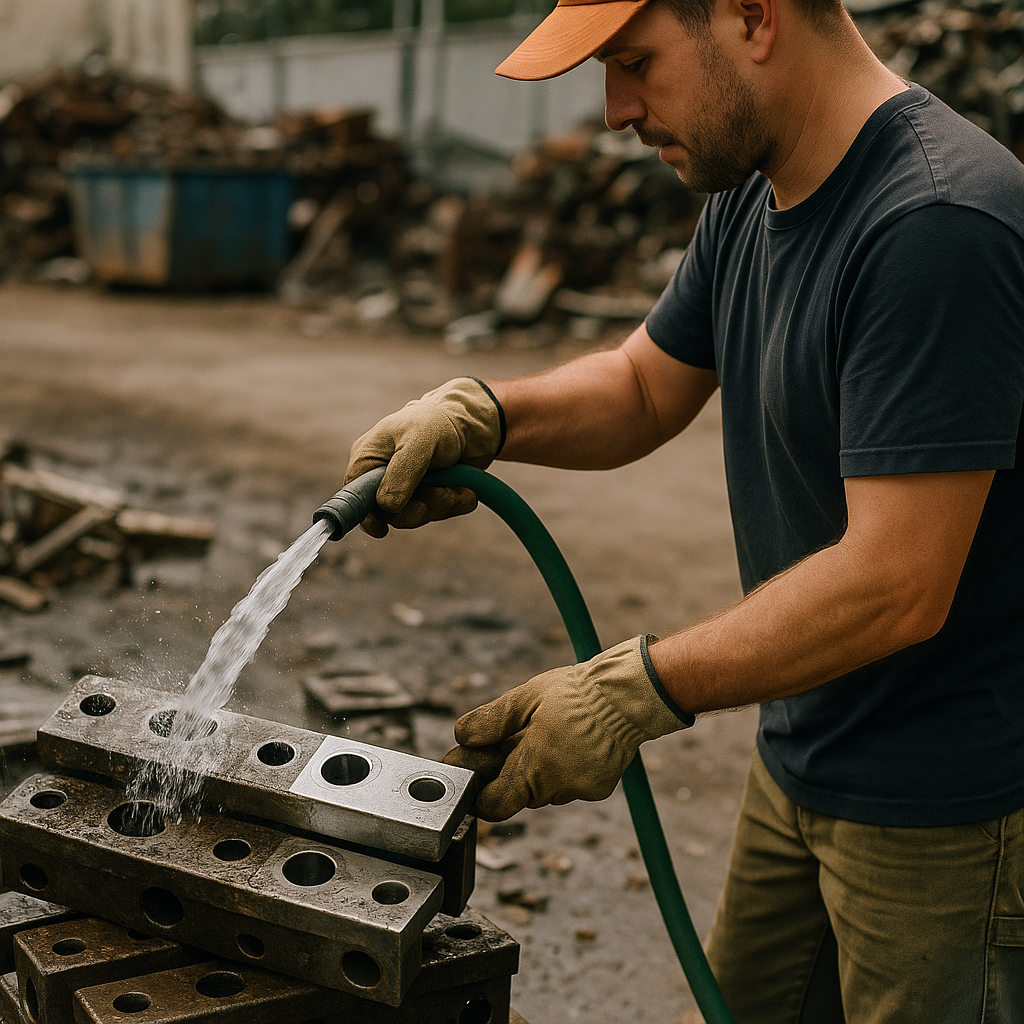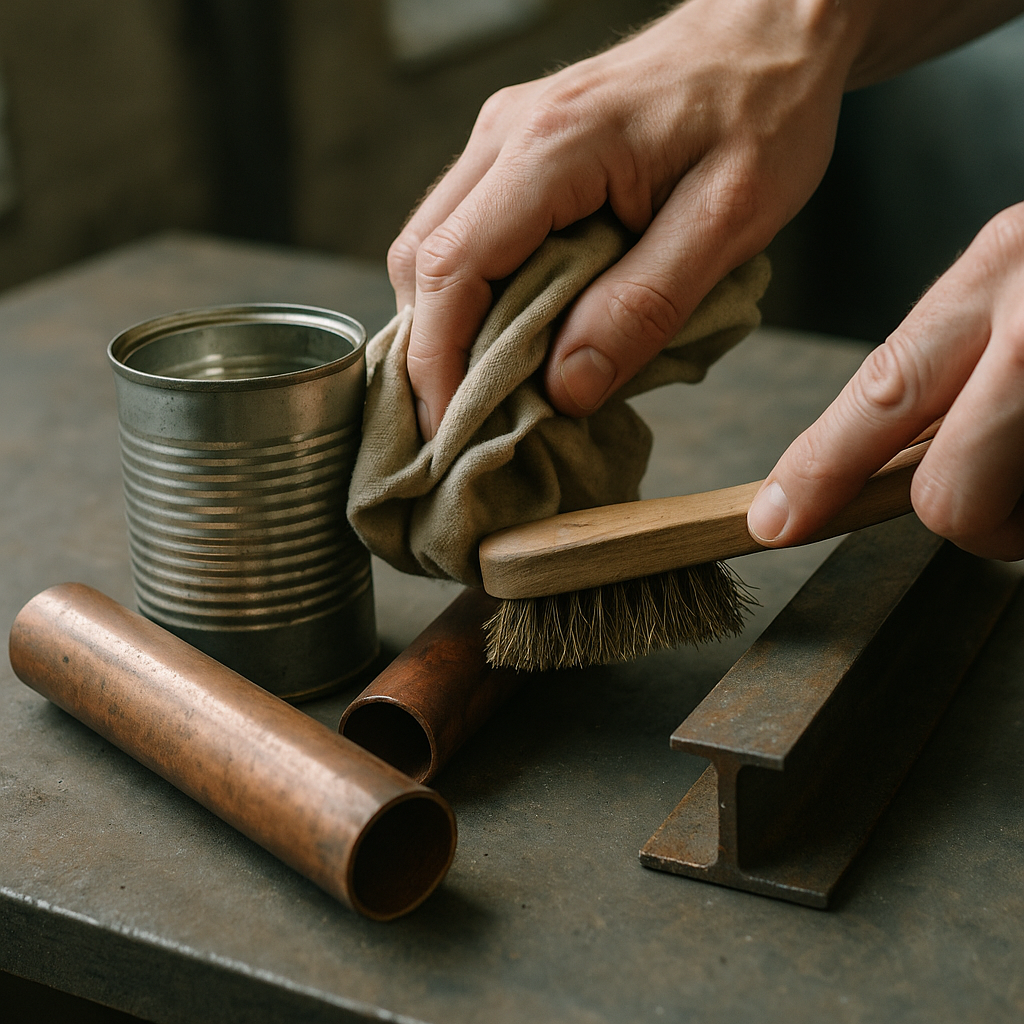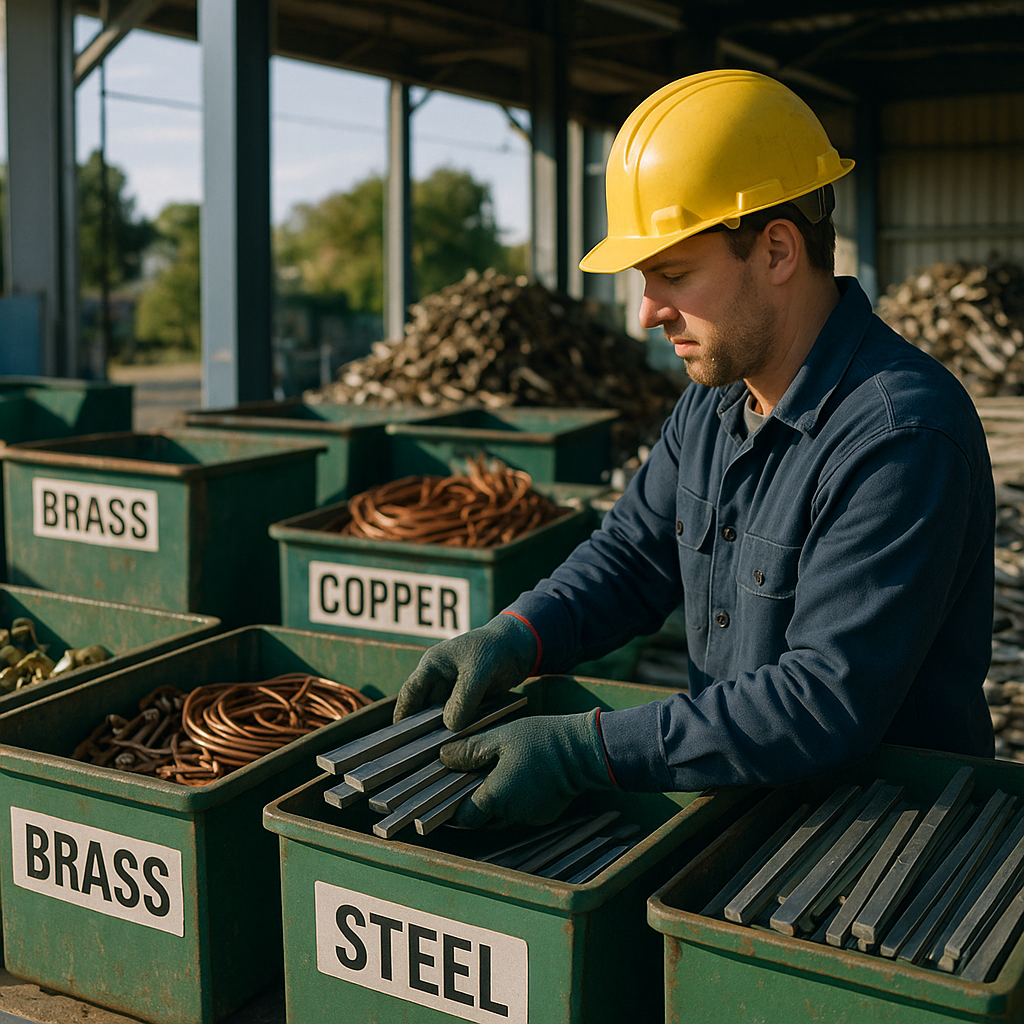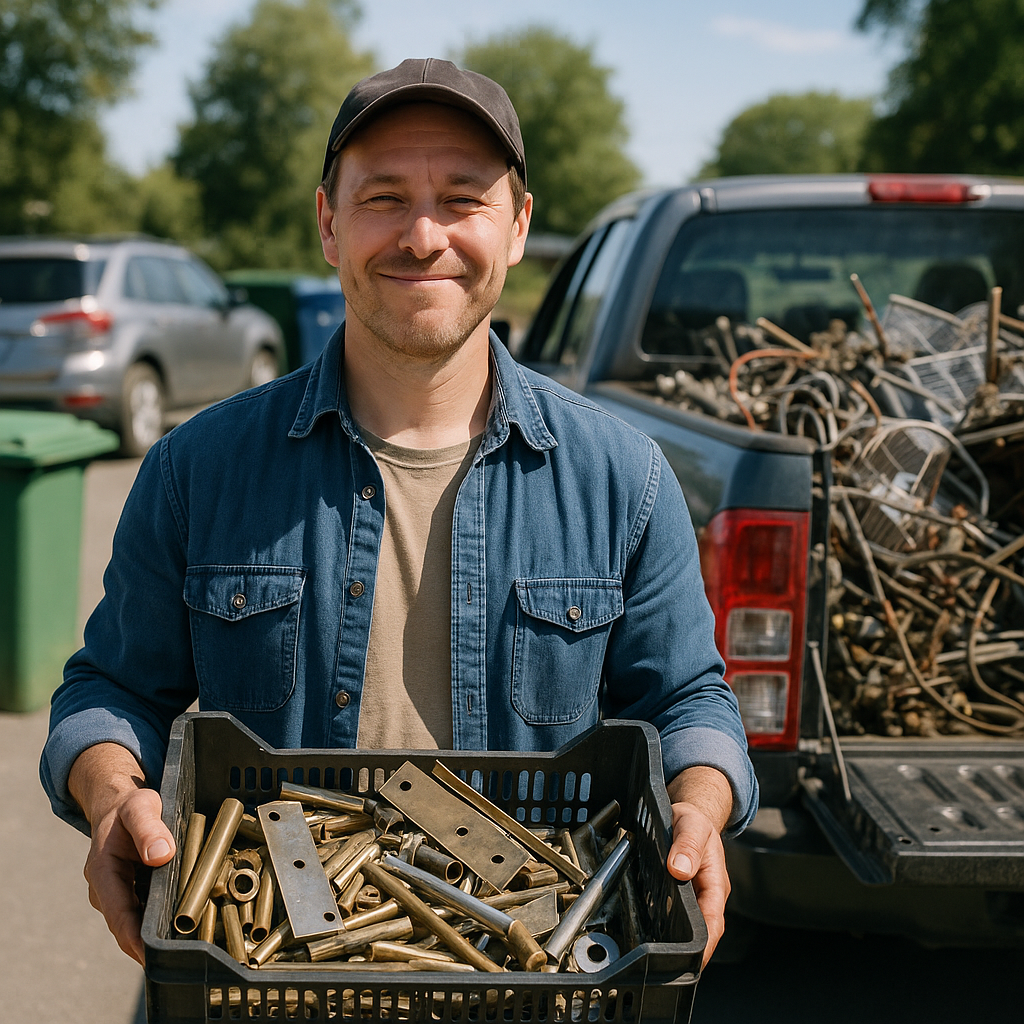5901 Botham Jean Blvd, Dallas, TX 75215
Do I Need to Clean Scrap Metal Before Recycling?
July 20, 2025Cleaning scrap metal before recycling is generally recommended, although it is not always strictly necessary. The level of cleaning required depends on the type of metal and your local recycling facility’s specific criteria. Most recyclers accept metal in various conditions, but cleaner scrap typically fetches higher prices.
Removing dirt, grease, and non-metal attachments from your scrap metal serves multiple purposes. It increases the material’s value by improving purity. Clean metals require less processing at recycling facilities, leading to better compensation for your materials. Thorough cleaning also makes the recycling process more efficient.
The financial benefits of cleaning your scrap can be significant. Recyclers consistently offer higher payouts for properly prepared materials. According to industry practices, customers who take the time to clean their scrap can receive substantially better rates than those who bring in contaminated materials. This price difference makes the extra preparation effort worthwhile for most recyclers.
What Are the Benefits of Cleaning Scrap Metal?

Cleaning scrap metal before recycling offers significant benefits for both recyclers and the environment. Removing contaminants creates a more valuable product and ensures efficient processing through the recycling system.
Higher Value and Better Pricing
Clean scrap metal commands premium prices at recycling facilities. By removing dirt, grease, paint, and other surface contaminants, you expose the pure metal, allowing recyclers to assess its true quality and composition.
For example, copper wire stripped of insulation can fetch up to three times more per pound than insulated wire. Similarly, aluminum free from plastics or rubber earns a higher rate than mixed materials that require additional processing.
Streamlined Recycling Process
Clean scrap metal significantly improves the recycling process’s efficiency. Contaminants can damage equipment, slow operations, or create quality issues in the final product.
When facilities receive pre-cleaned metal, they can process it more directly, using less energy and fewer resources. This efficiency translates to environmental benefits, including reduced energy consumption and lower greenhouse gas emissions.
Regulatory Compliance
Many recycling facilities must adhere to strict environmental regulations regarding the materials they accept. Clean scrap metal helps ensure compliance, preventing the potential rejection of your materials.
Certain contaminants like oils, chemicals, or hazardous materials may be regulated under environmental protection laws. Properly cleaning these substances from scrap metal avoids legal issues and environmental hazards.
Better Material Classification
Clean metal is easier to identify and sort accurately. When dirt and contaminants are removed, distinguishing characteristics become visible, allowing precise separation of different metal types.
This precise sorting is crucial because different metals have varying values and recycling processes. For instance, properly identified stainless steel can be worth significantly more than regular steel, but this distinction is challenging if the metal is covered in grime.
Reduced Environmental Impact
Cleaning scrap metal before recycling helps minimize environmental contamination. Oils, greases, and other substances can leach into soil or water systems during storage or processing if not properly removed.
By removing these contaminants beforehand, you help prevent potential pollution and contribute to more sustainable recycling practices. Clean metal also requires fewer chemicals and less water during industrial recycling processes.
Practical Cleaning Methods
Effective scrap metal cleaning doesn’t require industrial equipment. Here are some practical approaches:
- Use wire brushes or steel wool to remove surface rust and dirt
- Apply appropriate solvents to dissolve grease and oils
- Strip insulation from wires using manual wire strippers
- Disassemble composite items to separate metal from non-metal components
- Rinse with water to remove loose debris (ensuring proper disposal of runoff)
The effort invested in cleaning scrap metal typically pays off through higher prices and the knowledge that you’re contributing to more efficient recycling processes.
| Metal Type | Clean Scrap Value ($/lb) | Contaminated Scrap Value ($/lb) | Notes |
|---|---|---|---|
| Copper #1 Tubing | 3.50 | 3.30 (if painted or with solder) | Highest value for clean, unalloyed copper |
| Aluminum Clean Radiators | 0.50 | 0.15 (with tanks) | Higher value for radiators without tanks |
| 308 Stainless Steel | 0.30 | 0.15 (3% contamination) | Clean, non-magnetic stainless steel |
| Brass (Clean Yellow) | 2.40 | 1.10 (mixed with iron) | Includes mixed brass castings and chrome plated brass |
| Aluminum Cans | 0.48 (over 100 lbs.) | Varies | Higher value for cans without pet food or foil |
Remember that different recycling facilities may have varying requirements for cleanliness. Check with your local scrap yard about their specific guidelines to ensure you maximize the value of your materials while meeting their processing standards.
How Should I Clean Different Types of Scrap Metal?

Cleaning scrap metal properly is essential for maximizing its recycling value. Different metals require specific cleaning approaches to preserve their quality and ensure safety. The right cleaning method can significantly increase the worth of your scrap while making the recycling process more efficient.
General Cleaning Techniques
Before focusing on specific metal types, some universal cleaning practices apply to most scrap metals. Begin with basic debris removal to prepare your materials for more targeted cleaning.
For loose dirt and debris, using a stiff-bristled brush is effective for initial cleaning. Compressed air can blast away dust and small particles from hard-to-reach areas. For stubborn grime, warm water mixed with mild dish soap often works well.
Always wear heavy-duty gloves when handling scrap metal, as sharp edges can cause serious cuts. Safety glasses will protect your eyes from flying debris during the cleaning process.
Cleaning Ferrous Metals
Ferrous metals contain iron and are prone to rust. Steel, iron, and cast iron require special attention to remove oxidation and prepare them for recycling.
For light surface rust, use a wire brush to scrub affected areas. The brush bristles can reach into corners and crevices that other tools cannot. For heavier rust buildup, sandpaper is effective. Start with coarse grit and progress to finer grits for a cleaner finish.
Commercial rust removers provide a chemical alternative for severely rusted pieces. Apply the solution according to package instructions and rinse thoroughly afterward. Some recyclers prefer metal free from chemical residues.
Safety note: Always work in a well-ventilated area when using chemical rust removers, as the fumes can be harmful if inhaled in concentrated amounts.
Cleaning Non-Ferrous Metals
Non-ferrous metals like copper, aluminum, and brass fetch higher prices than ferrous metals. Proper cleaning ensures maximum value for these materials.
For copper pipes and wiring, remove all plastic insulation or coatings. Wire strippers make this process faster and more efficient. Clean copper with a solution of vinegar and salt to restore its natural luster. Rinse thoroughly with water afterward.
Aluminum responds well to gentle cleaning with mild detergent and water. Avoid harsh chemicals that might damage the metal surface. For oxidized aluminum, a mixture of cream of tartar and water creates an effective cleaning paste.
Brass items often develop tarnish over time. A paste made from equal parts salt, flour, and vinegar removes tarnish effectively. Apply the paste, let it sit for about 10 minutes, then rinse with warm water.
Handling Electronics and Appliances
Electronics and appliances contain valuable metals but require careful dismantling and cleaning.
First, remove all batteries, capacitors, and power sources, as these components may contain hazardous materials and should be disposed of properly at designated facilities. Circuit boards should be removed intact whenever possible, as they contain precious metals valued by recyclers.
For appliances, drain all fluids before cleaning. Refrigerators and air conditioners contain refrigerants that require professional removal, as these substances are harmful to the environment and regulated by law.
Remove plastic, rubber, and glass components from appliances. Pure metal scrap brings higher prices than mixed materials. Label separated components clearly for proper recycling.
Removing Coatings and Paints
Metal surfaces often have paint, powder coating, or other finishes that should be removed before recycling.
For small items, sanding effectively removes surface coatings. Power sanders speed up this process for larger pieces. Chemical paint strippers work well for intricate items with hard-to-reach areas. Apply the stripper according to manufacturer instructions and scrape away the loosened coating.
Heat guns can soften stubborn coatings for easier removal. Move the gun constantly to avoid overheating any area, which works particularly well for thick paints and industrial coatings.
Safety reminder: Always wear a respirator mask when removing paints or coatings. Many older paints contain lead and other toxic substances.
Oil and Grease Removal
Automotive and industrial scrap often contains oil and grease that must be removed before recycling.
Degreasers specifically formulated for metals work best for heavy contamination. Apply the degreaser liberally and allow it to penetrate the oil or grease. Rinse thoroughly with water after the recommended contact time.
For light oil residue, dish soap and hot water create an effective cleaning solution. The soap breaks down the oil for easier removal. Clean all degreased items with fresh water to remove any soap residue.
Collect all used cleaning solutions and dispose of them properly. Never pour oil-contaminated water down drains or storm sewers. Many communities offer hazardous waste disposal services for these materials.
Final Preparation Tips
After cleaning, take these final steps to ensure your scrap metal brings maximum value.
Dry all metal thoroughly before storage or transport. Moisture can cause new rust to form on freshly cleaned items. Sort your cleaned scrap by metal type. Separate containers for each metal type prevent cross-contamination.
Store cleaned scrap in a dry, covered area until ready for recycling. Exposure to weather can undo your careful cleaning work. Keep documentation of any special cleaning or preparation you performed, as this information may help you negotiate better prices with recyclers.
Remember that properly cleaned scrap metal not only brings higher prices but also contributes to more efficient recycling processes. Your efforts help conserve resources and reduce environmental impact.
| Scrap Metal Type | Cleaning Method | Notes |
|---|---|---|
| Copper | Vinegar and salt solution | Rinse thoroughly after cleaning |
| Aluminum | Mild detergent and water | Avoid harsh chemicals |
| Iron and Steel | Wire brush or sandpaper | Remove rust; work in a well-ventilated area |
| Brass | Paste of salt, flour, and vinegar | Let paste sit for 10 minutes before rinsing |
| General | Wire brushes, steel wool | Remove surface rust and dirt |
What Are the Best Practices for Preparing Scrap Metal for Recycling?

Properly preparing scrap metal is crucial for enhancing recycling efficiency and maximizing value. Strategic preparation involves more than just gathering metal items for drop-off. By employing effective techniques, you can improve your returns and support sustainable resource management.
Sorting Ferrous from Non-Ferrous Metals
The initial step in scrap metal preparation is distinguishing between ferrous and non-ferrous metals. This key difference affects both processing methods and value. Ferrous metals contain iron and are magnetic, whereas non-ferrous metals do not contain iron and are not magnetic.
Use a strong magnet—preferably a neodymium magnet—to identify the metal. If the magnet sticks, the metal is ferrous, like steel or iron. If it does not, it’s non-ferrous, such as copper, aluminum, or brass, which typically fetch higher prices.
Removing Non-Metallic Components
Metal purity significantly affects recycling value. Remove all non-metallic attachments like plastic, rubber, wood, or fabric from your scrap. For example, strip insulation from copper wires, remove wooden handles from tools, and detach plastic components from appliances.
This step can boost your scrap’s value by 15-40%. Clean metals require less processing, making them more valuable and easier to recycle.
Cleaning Your Scrap
Clean scrap is more valuable than dirty or contaminated materials. While perfect cleanliness isn’t always feasible, basic efforts to improve your scrap’s condition pay off. Wipe greasy or oily metals with rags to remove residue. For heavily soiled items, use a simple solution of dish soap and warm water.
Contaminated metals may be classified as lower grade. For example, painted aluminum or copper with solder may receive lower rates than clean materials. The effort in cleaning translates directly to better returns.
| #1 Bare Bright Copper Wire | Bare, uncoated, unalloyed copper wire without attachments. All insulation must be removed. |
| #1 Copper Tubing | Bare, uncoated, unalloyed copper bus bar/pipe without attachments. |
| #1 Flashing Copper | Bare, uncoated, unalloyed copper free of tar, corrosion, and paint. |
| #1 Heavy Melting Steel | Prepared pieces smaller than 60”x 24” over ¼“ thick. |
| #2 Copper Tubing | Burnt copper, copper with light tin coating, solder, or brass fittings still attached. |
| Steel | Separate ferrous metals, remove non-metal attachments. |
| Aluminum | Ensure non-magnetic separation, clean surface. |
| Copper | Strip insulation, clean, and remove any non-metal parts. |
| Brass | Remove non-metal attachments, clean thoroughly. |
| Lead | Ensure clean surface, remove contaminants. |
Size Reduction for Easier Handling
Consider cutting or breaking down larger items into smaller, more manageable pieces. This step aids in handling and transport. Smaller pieces also allow for better sorting since many items contain multiple metal types.
When dismantling complex items like appliances or electronics, separate valuable components—such as copper motors from steel frames—to increase returns. Always prioritize safety by using appropriate tools and protective gear.
Organizing for Efficient Transport
Once sorted and cleaned, organize your scrap into clearly labeled containers. Use sturdy bins, buckets, or heavy-duty bags for smaller pieces. For larger quantities, use dedicated containers for different metal types.
Proper organization prevents cross-contamination and streamlines the recycling center drop-off process. It also helps track your metal collection, allowing you to focus on high-value materials.
Research Local Requirements
Recycling facilities often have specific requirements for accepting scrap metal. Before transporting your materials, contact your local recycling center for their guidelines. Some facilities have size limitations or specific preparation requirements.
Understanding these requirements saves time and prevents material rejection. Many recycling centers provide specifications online or can share this information over the phone.
Safety Considerations
Safety should be a priority when handling scrap metal. Wear cut-resistant gloves for protection against sharp edges. Use safety glasses to protect your eyes from metal fragments. For heavy items, use proper lifting techniques or seek assistance.
Be cautious with items potentially containing hazardous materials, such as old electronics or appliances with refrigerants. These require special handling and may need to be taken to specialized recycling facilities.
Following these best practices not only increases the value of your scrap metal but also contributes to efficient recycling processes and resource conservation. The effort invested in proper preparation impacts both environmental outcomes and financial returns.
Conclusion: Maximizing the Value of Your Scrap Metal

Cleaning and preparing scrap metal before recycling isn’t just about tidiness—it’s a strategic approach that yields tangible benefits. By sorting different metals, removing contaminants, and preparing your materials properly, you can significantly increase their market value. The time spent stripping insulation from copper wires, removing non-metal attachments, and cleaning off dirt and debris leads to higher payouts from recycling facilities.
This preparation process serves a dual purpose. It not only puts more money in your pocket but also makes recycling more efficient and environmentally sustainable. Clean, properly sorted metals require less processing energy, reduce contamination risks, and streamline the recycling system. Your efforts help conserve natural resources and decrease the environmental impact of metal production. For your recycling needs, contact Okon Recycling at 214-717-4083.
